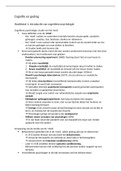Samenvatting
Quantitative Data Analysis 2 (QDA2) Book Summary - GRADE 9,0
- Vak
- Instelling
- Boek
Quantitative Data Analysis 2 (QDA2) summary of Andy Field's "Discovering Statistics Using IBM SPSS Statistics" (2017). The summary is 94 pages and includes all of the material covered in the course 6012B0423Y at the UvA.
[Meer zien]













